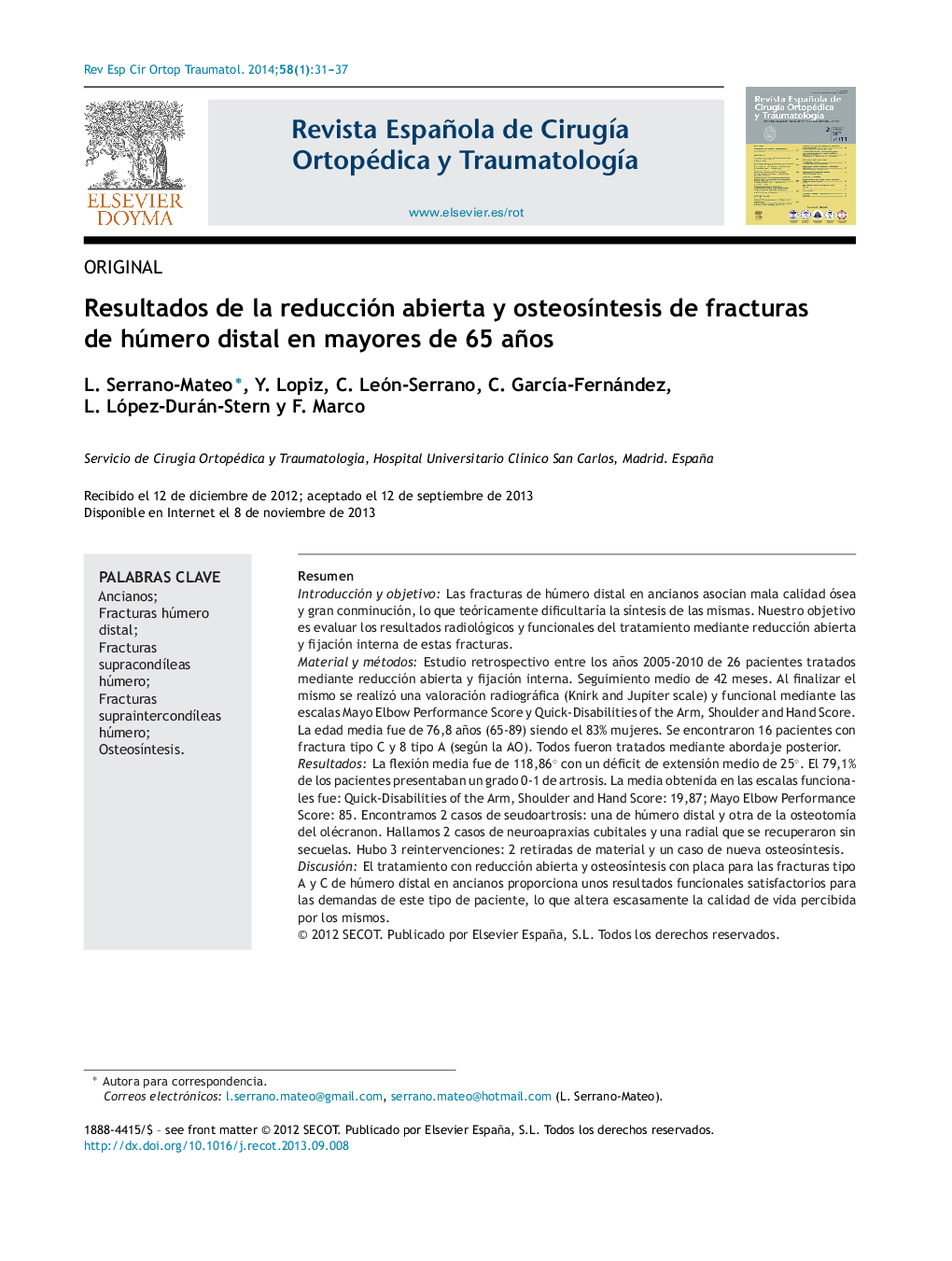| Article ID | Journal | Published Year | Pages | File Type |
|---|---|---|---|---|
| 4086417 | Revista Española de Cirugía Ortopédica y Traumatología | 2014 | 7 Pages |
ResumenIntroducción y objetivoLas fracturas de húmero distal en ancianos asocian mala calidad ósea y gran conminución, lo que teóricamente dificultaría la síntesis de las mismas. Nuestro objetivo es evaluar los resultados radiológicos y funcionales del tratamiento mediante reducción abierta y fijación interna de estas fracturas.Material y métodosEstudio retrospectivo entre los años 2005-2010 de 26 pacientes tratados mediante reducción abierta y fijación interna. Seguimiento medio de 42 meses. Al finalizar el mismo se realizó una valoración radiográfica (Knirk and Jupiter scale) y funcional mediante las escalas Mayo Elbow Performance Score y Quick-Disabilities of the Arm, Shoulder and Hand Score. La edad media fue de 76,8 años (65-89) siendo el 83% mujeres. Se encontraron 16 pacientes con fractura tipo C y 8 tipo A (según la AO). Todos fueron tratados mediante abordaje posterior.ResultadosLa flexión media fue de 118,86° con un déficit de extensión medio de 25°. El 79,1% de los pacientes presentaban un grado 0-1 de artrosis. La media obtenida en las escalas funcionales fue: Quick-Disabilities of the Arm, Shoulder and Hand Score: 19,87; Mayo Elbow Performance Score: 85. Encontramos 2 casos de seudoartrosis: una de húmero distal y otra de la osteotomía del olécranon. Hallamos 2 casos de neuroapraxias cubitales y una radial que se recuperaron sin secuelas. Hubo 3 reintervenciones: 2 retiradas de material y un caso de nueva osteosíntesis.DiscusiónEl tratamiento con reducción abierta y osteosíntesis con placa para las fracturas tipo A y C de húmero distal en ancianos proporciona unos resultados funcionales satisfactorios para las demandas de este tipo de paciente, lo que altera escasamente la calidad de vida percibida por los mismos.
Introduction and objectiveDistal humerus fractures in the elderly frequently associated with poor bone quality and comminution, making it harder to achieve proper osteosynthesis. Our aim is to evaluate the radiological and functional results of open reduction and internal fixation of these fractures.Material and methodsRetrospective study of 26 patients treated by open reduction and internal fixation between the years 2005-2010. Mean follow-up was 42 months. At final follow-up, a radiography evaluation (Knirk and Jupiter score) and clinical examination using Mayo Elbow Performance Score and Quick-Disabilities of the Arm, Shoulder and Hand Score was performed. Mean age of the group was 76.8 years (65-89), with 83% of the patients being female. Sixteen patients suffered type C fractures and 8 type A by AO classification. All underwent posterior surgical approach.ResultsMean elbow flexion reached 118.86°, with a mean extension deficit of 25°. More than 3-quarters (79.1%) of the patients showed 0-1 grade degenerative changes on the X-ray films at final follow-up. Functional results reached an average 19.87 points on Quick-Disabilities of the Arm, Shoulder and Hand Score, and 85 points on Mayo Elbow Performance Score scores. Non-union occurred in 2 cases: distal humerus in one patient and olecranon osteotomy in another. Ulnar nerve neuropraxia was recorded in 2 cases, and radial nerve in one. All 3 recovered uneventfully. Revision surgery was required, with 2 patients needing hardware removal and one a new fixation.DiscussionTreatment by open reduction and internal fixation with plating in elderly people for type A and C distal humerus fractures gives good functional results regarding this population, and thus scarcely disturbs their quality of life.
